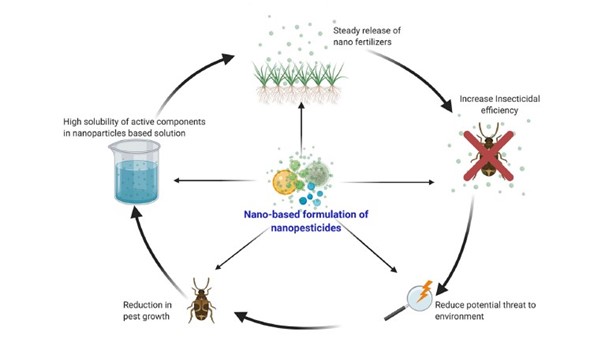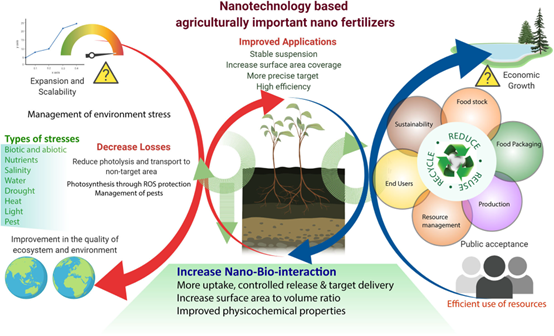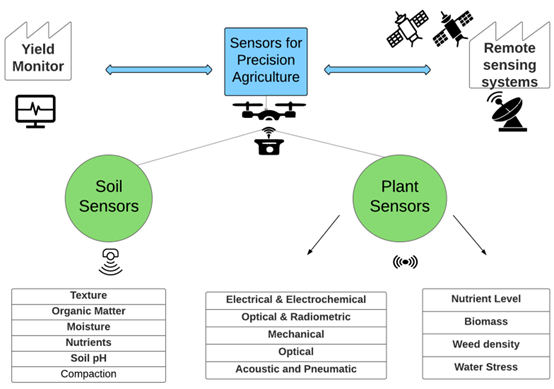Nanotechnology in Agriculture: Nanopesticides and Nanofertilisers
Applications in the Agricultural Sector. Toxicological Assessment, Safety Issues, Regulatory Aspects, and Health Risks of NMs.
The use of nanopesticides, nanofertilizers, and devices like nanosensors has demonstrated the potential of nanotechnology to promote growth in the agricultural sector. By enhancing soil productivity, nanofertilisers promote a slow release of nutrients. They boost market expansion by increasing nutrient utilisation effectiveness and reducing nutrient loss. Increased nutrient availability causes plants’ photosynthetic performance to improve, which results in higher yield and dry matter production. By reducing the frequency at which chemical fertilisers are used and hence the toxicity of the soil, the use of nanofertilisers is beneficial. Therefore, nanotechnology could prove to be a method with enormous promise for enhancing agricultural output and assisting in the development of sustainable agriculture. The most promising-designed components being tested for soil are nanofertilisers. Nanofertilisers have shown beneficial results. The three types of nanofertilisers are nanoscale additives, nanoscale fertilisers, and nanoscale coatings. In addition to this, the farming community can reduce agrochemicals while maintaining high crop output, conserving soil and water health, and contributing to a cleaner environment by embracing nanotechnology-based precision agriculture practices (1). For all the aforementioned factors, the nanofertilisers market is anticipated to experience the fastest CAGR (Compound annual growth rate) throughout the forecast period 2023-2030 according to a recent agricultural-nanotechnology-market report (2).
What are the Nanopesticides and how they are used in Agriculture?
Pesticides are used to increase and improve agricultural yield and efficiency by shielding plants from harmful factors such as insects and plant diseases (3). However, it has been observed that the use of pesticides is toxic and lethal for the environment, and that many of them are dangerous and fatal for both human and animal health. As a result, numerous pesticides have been restricted by national or international authorities. To improve agronomic productivity and efficiency and lessen the impact on the environment, some factors must be taken into account. Nanotechnology offers a unique and superior approach to the challenging and costly task of creating effective and safe pesticides (4). The nano pesticide trials that occur most frequently are nano herbicides, nano insecticides, nano nematocides, and nano fungicides. The top example of a nano-insecticide is nanostructured alumina (NSA), which is an insecticide created from nanoengineered material. It is created by oxidising a metal, which has a fixed electric charge. NSA was created using advanced nanotechnology so that it may use its system to fight insects. Positively charged insect charges interact with negatively charged NSA particles mostly through powerful electrical bonding. Through the powerful sorptive ability of the NSA particle, which detaches the insect’s cuticle, a fibrous composite of chitin, this interaction leads the insect to become dehydrated, leading to the bug’s inevitable death from dehydration. Because of its small size, inherent electric charge, sorbative prosperity, and vast surface area, NSA has a high insecticidal effect (Figure 1) (5).

Figure 1. Advantages of nano-based agricultural chemicals: Even when used in lower quantities, nano-fertilisers supply nutrients to plants or improve the effects of fertilisers. The fertilisers can be encapsulated in nanoform to improve nutrient uptake. Finally, it lessens the danger of environmental degradation, reduces nutrient loss, and enhances crop quality and production (6).
Additionally, the pesticide industry places a high demand on the packaging of conventional pesticides with NPs or polymers because they are expected to address these issues by improving pesticide efficiency, boosting production, decreasing excess run-off by gradual release of active ingredients over a prolonged period of time, and ultimately protecting the environment (7). During the entire period of insect growth (from the transition from larva to the maturity stage), nanoformulation or nano carriers serve as the vehicle to transport and manage delivery or release of the active compound, which is present in its core. For example, sustainable nano carrier construction of chitosan liposome which encapsulates the inner core is comprised of alpha-cypermethrin or etofenprox. Similar to NMs, many nanoformulations of conventional pesticides have been created, and they exhibit a considerable impact on pest control. Some nanopesticides are already on the market but it may take years for their connection to the controlled release of agrochemicals to be established (Figure 1).
What are the Nanofertilisers and How they are used in Agriculture?
It is common agricultural practise to replenish important nutrients in the soil with conventional fertilisers, such as urea, nitrogen, phosphorous, potassium, monoammonium phosphate, and diammonium phosphate. However, leaching from conventional fertilisers results in low nutrient utilisation efficiency, which causes significant financial losses and decreased soil fertility. The amount of soil fertility has significantly decreased as a result of the leaching of these nutrients from the soil. This is mostly caused by the conventional fertilisers’ relatively low nutrient utilisation efficiency, which is approximately 30–35% fornitrogen, 18–20% for phosphorus, and 35–40% for potassium. Nanofertilisers have evolved as a potential solution to such problems, with increased efficiency and lower environmental effects (Figure 2). They are categorised according to their action, nutrient composition, and consistency. Among these categories are controlled release nanofertilisers, nanofertilisers for targeted delivery, plant growth-stimulating nanofertilisers, water and nutrient loss-controlling fertilisers, inorganic and organic nanofertilisers, hybrid nanofertilisers, nutrient-loaded nanofertilisers, and various consistency based nanofertilisers such as surface-coated, synthetic polymer-coated, biological product coated, and nanocarrier-based nanofertilisers (Figure 3). Understanding the nature of the nanofertiliser is critical for determining the appropriate way of application. Nanofertilisers can be applied to plants in three ways: foliar, water, and soil (9).

Figure 2. Agriculture-relevant nano-fertilisers based on nanotechnology boost agronomic efficiency and productivity while lowering environmental stress. Use of nanotechnology effectively in agriculture for long-term sustainability (6).

Figure 3. The categorization of nanofertilisers (8).
Precision Agriculture and Nanotechnology
Precision agriculture (PA) based on nanotechnology employs computers, global positioning systems (GPS), and remote sensing devices to measure crop-based and environmental factors (10) (Figure 4). These nanotechnology-based tracking technologies provide a number of advantages for the agricultural industry. Farmers and food manufacturers can ensure the quality and safety of their products, reduce waste by identifying issues early, improve efficiency by tracking products through the supply chain, increase transparency, and build trust with consumers by providing information about the origin and safety of their products by using nanotechnology to tag, monitor, and track agroproducts (1). PA practises have been implemented in the Nakhon Ratchasima vineyards in Thailand (11). Similar procedures are also used in the United States (12) and Brazil (13).

Figure 4. Nanosensors’ functional representation in precision agriculture (1)
Nanoparticles risk and health hazards toxicological impact in agriculture application
Nanotechnology in foods and pesticides is governed by the European Chemicals Agency (ECHA) and the European Food Safety Authority (EFSA) in the European Union. Safety-by-design (SbD) synthesis methods have been the focus of the development of harmonised regulatory frameworks in the field of nanosafety (14). Most of the time, nanosafety researchers employ a two-way method (15). Understanding human health toxicity, which is primarily directed at organisms, tissues, and cells (such as mouse skin and immune cells), is the first step. Communities are mostly concerned with other parts of the tree of life, such as single-cell organisms, plant tissues, invertebrates, and fish. Therefore the second category is environmental health risk. Plant-based nanosafety research is currently focusing on intended or unintentional exposure of food crops to particular NMs (such as spray drifting, leaching, and runoff of NPs), as well as intentional or direct exposure of food crops to specific NMs (for example, nano insecticides, nano fertiliser, and nanoherbicides) (Figure 5). The use of pesticide nanoforms is governed by Regulation (EU) 2018/1881 on the Registration, Evaluation, Authorisation, and Restriction of Chemicals (REACH), which is connected to Commission Recommendation 2011/696/EU on the definition of a nanomaterial.
Figure 5. The Strategy for the agri-food industry’s risk evaluation of nanotechnology: Nanopesticides and nanofertilisers that are applied directly to plants have the potential to cause ROS, which can damage intracellular organelles’ functions. Indirect release (i.e. released from food processing and packaging, as well as from agricultural products) leads to occupational exposure to humans (i.e. from industrial operations, coming into contact with nanopesticides and nanofertilisers directly). To increase the sustainability of agricultural nanotechnology, a risk framework for risk assessment, risk management, policymaking, and to facilitate risk communication among the various stakeholders has been created (6).
You can read also:
How nanotechnology is used in agriculture
References
- Yadav, A., Yadav, K., Ahmad, R., Abd-Elsalam, K.A. (2023) Emerging Frontiers in Nanotechnology for Precision Agriculture: Advancements, Hurdles and Prospects. Agrochemicals, 2, 220–256. https://doi.org/10.3390/agrochemicals2020016
- https://www.datamintelligence.com/research-report/agricultural-nanotechnology-market
- Jampílek, J., and Králová, K. (2017) “Nanopesticides: preparation, targeting, and controlled release,” in New Pesticides and Soil Sensors, ed A. M. Grumezescu (Academic Press), 81–127. https://doi.org/1016/B978-0-12-804299-1.00004-7
- Sasson, Y., Levy-Ruso, G., Toledano, O., and Ishaaya, I. (2007) “Nanosuspensions: emerging novel agrochemical formulations,” in Insecticides Design Using Advanced Technologies (Berlin; Heidelberg: Springer), 1–39. https://doi.org/1007/978-3-540-46907-0_1
- Stadler, T., Buteler, M., Valdez, S. R., and Gitto, J. G. (2018) Particulate nanoinsecticides: a new concept in insect pest management. Agricul. Toxicol. 83:72448. https://doi.org/10.5772/intechopen.72448
- Mittal, D., Kaur, G., Singh, P., Yadav, K. and Ali, S.A. (2020) Nanoparticle-Based Sustainable Agriculture and Food Science: Recent Advances and Future Outlook. Nanotechnol. 2:579954, https://doi.org/10.3389/fnano.2020.579954
- Nuruzzaman, M. D., Rahman, M. M., Liu, Y., and Naidu, R. (2016) Nanoencapsulation, nano-guard for pesticides: a new window for safe application. Agric. Food Chem. 64, 1447–1483. https://doi.org/10.1021/acs.jafc.5b05214
- Yadav, A., Yadav, K., Abd-Elsalam, K.A. (2023) Nanofertilizers: Types, Delivery and Advantages in Agricultural Sustainability. Agrochemicals 2023, 2, 296–336. https://doi.org/10.3390/agrochemicals2020019
- Saraiva, R., Ferreira, Q., Rodrigues, G.C., Oliveira, M. (2022) Phosphorous nanofertilisers for precise application in rice cultivation as an adaptation to climate change. Climate, 10 (11), 183, https://doi.org/3390/cli10110183
- Kaushal, M., Wani, S.P. (2017) Nanosensors: Frontiers in precision agriculture. Agric. Paradig., 279–291. https://doi.org/10.1007/978-981-10-4573-8_13
- Tongrod, N., Tuantranont, A., Kerdcharoen, T. (2009) Adoption of precision agriculture in vineyard. In Proceedings of the 2009 6th International Conference on Electrical Engineering/Electronics, Computer, Telecommunications and Information Technology, Chonburi, Thailand, 6–9 May 2009; IEEE: Piscataway, NJ, USA.
- Popp, J. and Griffin, T. (2000) Adoption trends of early adopters of precision farming in Arkansas. In Proceedings of the 5th International Conference on Precision Agriculture, Bloomington, MI, USA, 16–19 July.
- Pivoto, D., Waquil, P.D., Talamini, E., Finocchio, C.P., Dalla Corte, V.F., de Vargas Mores, G. (2018) Scientific development of smart farming technologies and their application in Brazil. Process. Agric., 5, 21–32. https://doi.org/10.1016/j.inpa.2017.12.002 2214-3173
- Kraegeloh, A., Suarez-Merino, B., Sluijters, T., and Micheletti, C. (2018) Implementation of safe-by-design for nanomaterial development and safe innovation: why we need a comprehensive approach. Nanomaterials 8:239, https://doi.org/10.3390/nano8040239
- Bos, P. M., Gottardo, S., Scott-Fordsmand, J. J., Van Tongeren, M., Semenzin, E., Fernandes, T. F., et al. (2015). The marina risk assessment strategy: a flexible strategy for efficient information collection and risk assessment of nanomaterials. J. Environ. Res. Public. Health 12, 15007–15021, https://doi.org/10.3390/ijerph121214961










































































